Entry tags:
More travelogue
The city of Seville, according to our tour guide, started as a Phoenician colony, named something like "isbili". The Romans conquered the area and renamed it with a Latin word that sounded like "isbili" and meant "flat" (because Seville, unlike so many Spanish cities, isn't all uphill both ways). The Visigoths conquered the area (about the time St. Isidore of Seville was born, speaking of etymology), and probably kept the Latin name. The Moors conquered the area and renamed the city "Isbiliyya". Then the Spanish Christians conquered the area and renamed it "Sevilla", subsequently famous for barbers and oranges.
We spent the next night in Mérida, which started when Caesar Augustus, in about 25 BCE, wanted to thank his soldiers with gifts of land, somewhere far away that land was cheap and there was a need to mix more Roman citizens into the populace. Ex-soldiers were "emereti", so he founded a retirement community in Spain named "Augusta Emereti", which also served as the capital of the province of Lusitania (most of modern Portugal and west-central Spain). The city started to go downhill in the 5th century with the withdrawal of the Roman empire, and in the 6th century the Visigoths conquered the area. By a miracle of Sta. Eulalia, who was born in the city, the Visigoths didn't sack the city but merely installed themselves as the new owners. A hundred years later, the Moors conquered the area, and apparently didn't do a lot of sacking either; I didn't catch what name they used for the city, but it probably sounded somewhere between "emereti" and "merida". 600 years later, the Spanish Christians conquered the area and renamed the city "Mérida".
I had picked Mérida for this one-night stay because it was halfway between Sevilla and Salamanca, but in retrospect we could easily have spent another full day here (as well as another half day visiting Templar castles on the way from Sevilla to Mérida). This city doesn't have a lot of medieval stuff, but it's FULL of Roman ruins.
 Two blocks' walk from our hotel was the mostly-excavated remains of a Roman mansion, with an atrium, three patios, private baths, winter (ground-level) and summer (underground) bedrooms, substantial surviving painted frescoes on the walls, and a number of gorgeous floor mosaics.
Two blocks' walk from our hotel was the mostly-excavated remains of a Roman mansion, with an atrium, three patios, private baths, winter (ground-level) and summer (underground) bedrooms, substantial surviving painted frescoes on the walls, and a number of gorgeous floor mosaics.
Another block to a Roman columbarium, where the residents of Augusta Emereti from 1st-4th centuries CE buried either ashes or whole bodies.

Another three blocks takes you to Mérida's archaeological crown jewels, a 6000-seat Roman theatre and adjacent 14000-seat gladiatorial amphitheatre. These huge sites were unknown until the late 19th century, when archaeologists tripped over more and more signs that there was something big underground. At right is the paved street that curved around the amphitheatre, with speed bumps. The first picture below is the amphitheatre, at least the lower and middle ranks of seats (the cheap, nosebleed seats above are gone); the cross-shaped space in the middle had a wooden floor over it, and that's where the fights took place, with baton-wielding marshals ensuring that the rules were followed. Anyway, the theatre and amphitheatre have both been excavated, with the proscenium of the stage in remarkably good condition, and the theatre has been restored to the point that it can be used for actual theatrical productions (although not at this time of year).
Next door to the theatre and amphitheatre is the large, modern Museo Nacional del Arte Romano, which we didn't even set foot inside; that would have been several more hours. It also has an annex of Visigothic art in a separate building a few blocks away. But we visited the Basilica of Sta. Eulalia, where the altar is allegedly built over the tomb of the Saint herself. Also saw another of the numerous Roman baths in the city, and the portico welcoming people to the town forum (with faces of Jove and Medusa?), and the Temple of Diana.
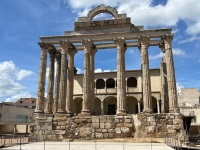
The Temple of Diana was indeed a Roman pagan temple, but we don't know to whom; it was attributed to Diana by the 17th-century property owner. When the Roman Empire went Christian, it was probably repurposed but not much changed; when the Visigoths took over, they repurposed it again and built a smaller building nearby; when the Moors took over, they repurposed it again but didn't do too much damage to the architecture; when the Spanish Christians took over, they also didn't do too much damage to the architecture, and allowed the city's Jews to set up a synagogue next door; when the Jews were kicked out in 1492, the synagogue became a church, but IIUC the Roman-era temple was still standing. The aforementioned 17th-century property owner, whose family emblem was a crow, built a Renaissance palazzo named "Casa de las Corbas" incorporating much of the temple's remains in situ. 18th-, 19th-, and 20th-century architects picked apart this layer cake of influences, dismantled parts of the Renaissance palazzo but left parts of it standing, both for its own historical significance and in thanks that it had preserved much of the temple. The palazzo now houses a bunch of modern displays and dioramas about the history of the site.
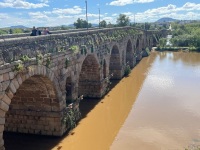
Anyway, we were running low on time, so we took only a quick look at the Roman bridge (750m or so long) and the adjacent 9th-century Moorish Alcazaba, the oldest surviving Moorish fortification in Spain. Then returned to the hotel, retrieved our suitcases and car, and drove 3 hours to Salamanca, where we are now.
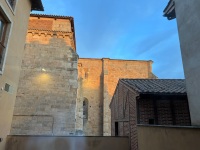
The window of our hotel room looks out at the back of the Catedral Viejo, started in the 12th century.
We spent the next night in Mérida, which started when Caesar Augustus, in about 25 BCE, wanted to thank his soldiers with gifts of land, somewhere far away that land was cheap and there was a need to mix more Roman citizens into the populace. Ex-soldiers were "emereti", so he founded a retirement community in Spain named "Augusta Emereti", which also served as the capital of the province of Lusitania (most of modern Portugal and west-central Spain). The city started to go downhill in the 5th century with the withdrawal of the Roman empire, and in the 6th century the Visigoths conquered the area. By a miracle of Sta. Eulalia, who was born in the city, the Visigoths didn't sack the city but merely installed themselves as the new owners. A hundred years later, the Moors conquered the area, and apparently didn't do a lot of sacking either; I didn't catch what name they used for the city, but it probably sounded somewhere between "emereti" and "merida". 600 years later, the Spanish Christians conquered the area and renamed the city "Mérida".
I had picked Mérida for this one-night stay because it was halfway between Sevilla and Salamanca, but in retrospect we could easily have spent another full day here (as well as another half day visiting Templar castles on the way from Sevilla to Mérida). This city doesn't have a lot of medieval stuff, but it's FULL of Roman ruins.
 Two blocks' walk from our hotel was the mostly-excavated remains of a Roman mansion, with an atrium, three patios, private baths, winter (ground-level) and summer (underground) bedrooms, substantial surviving painted frescoes on the walls, and a number of gorgeous floor mosaics.
Two blocks' walk from our hotel was the mostly-excavated remains of a Roman mansion, with an atrium, three patios, private baths, winter (ground-level) and summer (underground) bedrooms, substantial surviving painted frescoes on the walls, and a number of gorgeous floor mosaics. |
 |
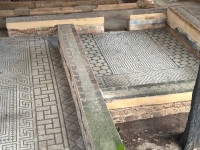 |
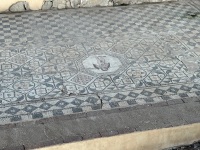 |
 |
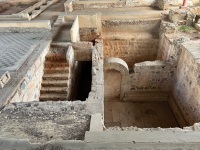 |
Another block to a Roman columbarium, where the residents of Augusta Emereti from 1st-4th centuries CE buried either ashes or whole bodies.

Another three blocks takes you to Mérida's archaeological crown jewels, a 6000-seat Roman theatre and adjacent 14000-seat gladiatorial amphitheatre. These huge sites were unknown until the late 19th century, when archaeologists tripped over more and more signs that there was something big underground. At right is the paved street that curved around the amphitheatre, with speed bumps. The first picture below is the amphitheatre, at least the lower and middle ranks of seats (the cheap, nosebleed seats above are gone); the cross-shaped space in the middle had a wooden floor over it, and that's where the fights took place, with baton-wielding marshals ensuring that the rules were followed. Anyway, the theatre and amphitheatre have both been excavated, with the proscenium of the stage in remarkably good condition, and the theatre has been restored to the point that it can be used for actual theatrical productions (although not at this time of year).
 |
 |
 |
Next door to the theatre and amphitheatre is the large, modern Museo Nacional del Arte Romano, which we didn't even set foot inside; that would have been several more hours. It also has an annex of Visigothic art in a separate building a few blocks away. But we visited the Basilica of Sta. Eulalia, where the altar is allegedly built over the tomb of the Saint herself. Also saw another of the numerous Roman baths in the city, and the portico welcoming people to the town forum (with faces of Jove and Medusa?), and the Temple of Diana.

The Temple of Diana was indeed a Roman pagan temple, but we don't know to whom; it was attributed to Diana by the 17th-century property owner. When the Roman Empire went Christian, it was probably repurposed but not much changed; when the Visigoths took over, they repurposed it again and built a smaller building nearby; when the Moors took over, they repurposed it again but didn't do too much damage to the architecture; when the Spanish Christians took over, they also didn't do too much damage to the architecture, and allowed the city's Jews to set up a synagogue next door; when the Jews were kicked out in 1492, the synagogue became a church, but IIUC the Roman-era temple was still standing. The aforementioned 17th-century property owner, whose family emblem was a crow, built a Renaissance palazzo named "Casa de las Corbas" incorporating much of the temple's remains in situ. 18th-, 19th-, and 20th-century architects picked apart this layer cake of influences, dismantled parts of the Renaissance palazzo but left parts of it standing, both for its own historical significance and in thanks that it had preserved much of the temple. The palazzo now houses a bunch of modern displays and dioramas about the history of the site.

Anyway, we were running low on time, so we took only a quick look at the Roman bridge (750m or so long) and the adjacent 9th-century Moorish Alcazaba, the oldest surviving Moorish fortification in Spain. Then returned to the hotel, retrieved our suitcases and car, and drove 3 hours to Salamanca, where we are now.

The window of our hotel room looks out at the back of the Catedral Viejo, started in the 12th century.
